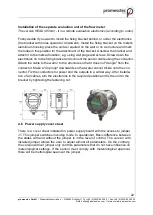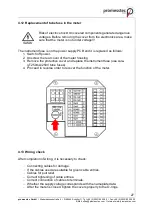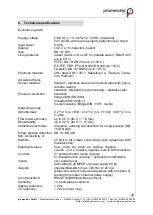
14
promesstec GmbH
I Niedersachsenstraße 4 I D-48465 Schüttorf I Tel.:+49 (0)5923/ 90 229 0 I Fax:+49 (0)5923/ 90 229 29
E-Mail: [email protected] I Internet: www.promesstec.com
The installation is carried out by fixing it between the counter flanges (sandwich)
welded on the calming pipe (5D before, 3D behind and downstream) whereas the
liquid must flow through the flow sensor in the direction indicated on it with an arrow.
When counter flanges are being welded on the pipe, it is essential to maintain their
alignment so as to ensure uniformity of seating faces of the flanges on the face
areas of the sensor (however, this must not be reached by uneven tightening of the
connecting bolts because there is a risk of leakage resulting from temperature strain
in the future and, in some case, the measuring tube might crack when being tight-
ened unevenly). The difference in LMAX and LMIN distances of the both sealing
faces on the flanges before the flow sensor is installed, must not be longer than 0.5
mm.
In the same way, the mating positions of holes for connecting bolts in counter-
flanges should be ensured as well as ample room behind the flanges for the con-
necting bolts and nuts in order to ensure proper installation of the sensor in the pipe
and the attachment by connecting bolts.
The manufacturer recommends using a fitting adapter for welding. It is absolutely
inadmissible to use the flow meter as a fitting adapter due to possible thermal de-
struction. The welding current must not flow through the flow sensor during electric
welding. The installation of the flow sensor itself is carried out after all welding, paint-
ing, building, and similar jobs are finished.
If the flow sensor has a fibre-rubber sealing, it is inevitable to lubricate it using graph-
ite grease or oil with graphite.





























